Improving Urban Ecological Welfare Performance: An ST-LMDI Approach to the Yangtze River Economic Belt
Abstract
:1. Introduction
2. Literature Review
2.1. Measurement Research on EWP
2.2. Research Methods of Influencing Factors of EWP
2.3. Research Gaps
3. Materials and Methods
3.1. Study Area and Data Source
3.1.1. Study Area
3.1.2. Data Source
3.2. Methods
3.2.1. Ecological Footprint Model
3.2.2. Measure the HDI
3.2.3. Measure the EWP
3.2.4. ST-LMDI Model
4. Results
4.1. Spatiotemporal Evolution of EWP in the YREB
4.2. Temporal Decomposition Results of EWP in the YREB
4.2.1. City-Level Decomposition Results
4.2.2. Region-Level Decomposition Results
4.3. Spatial Decomposition Results of EWP in the YREB
4.3.1. City-Level Decomposition Results
4.3.2. Region-Level Decomposition Results
5. Discussion
5.1. Temporal and Spatial Changes in EWP and Their Causes
5.2. Regional Heterogeneity and Its Policy Implications
5.3. Research Limitations and Future Prospects
6. Conclusions
- (1)
- From 2006 to 2022, the EWP of the Yangtze River Economic Belt exhibited a “W”-shaped trend in both time and space, underscoring the intricate interplay and dynamic equilibrium between urban ecological conservation and economic growth.
- (2)
- Significant regional heterogeneity characterizes the urban EWP within the Yangtze River Economic Belt, with higher performance notably in the downstream area. This can be attributed to the region’s earlier industrialization and market-oriented reforms.
- (3)
- Social and economic benefits are paramount among the factors influencing EWP. Social benefits exert varying influences—positive and negative—at different times, while economic benefits consistently demonstrate a positive, propelling effect.
- (4)
- In the context of the Yangtze River Economic Belt, it is essential to account for the impact of three key factors on EWP: population dispersion, urban population density, and ecological sustainability.
- (5)
- To attain the Yangtze River Economic Belt’s long-term objectives of harmonized regional development, ecological stewardship, and green transformation, it is imperative to devise tailored EWP enhancement strategies for each city. These strategies should address both the consumption of urban ecological resources and the improvement of residents’ comprehensive welfare. They should also aim to strengthen ecological resource management, thereby boosting urban ecological sustainability, fostering regional urban–rural integration, and optimizing urban population distribution to elevate the overall welfare of residents.
Author Contributions
Funding
Data Availability Statement
Conflicts of Interest
References
- Cui, S.; Wang, Y.; Xu, P.; Li, L. Ecological welfare performance, industrial agglomeration and technological innovation: An empirical study based on Beijing–Tianjin–Hebei, Yangtze River Delta and Pearl River Delta. Environ. Dev. Sustain. 2022, 26, 1505–1528. [Google Scholar] [CrossRef]
- Peng, J.; Liu, Y.; Wang, Q.; Tu, G.; Huang, X. The Impact of New Urbanization Policy on In Situ Urbanization—Policy Test Based on Difference-in-Differences Model. Land 2021, 10, 178. [Google Scholar] [CrossRef]
- Bian, J.; Lan, F.; Hui, Z.; Bai, J.; Wang, Y. Ecological Well-Being Performance Evaluation of Chinese Major Node Cities along the Belt and Road. Land 2022, 11, 1928. [Google Scholar] [CrossRef]
- Lan, F.; Hui, Z.; Bian, J.; Wang, Y.; Shen, W. Ecological Well-Being Performance Evaluation and Spatio-Temporal Evolution Characteristics of Urban Agglomerations in the Yellow River Basin. Land 2022, 11, 2044. [Google Scholar] [CrossRef]
- Daly, H.E. Sustainable Development: From Concept and Theory to Operational Principles. Popul. Dev. Rev. 1990, 16, 25–43. [Google Scholar] [CrossRef]
- Zhang, X. Theory of Sustainable Development: Concept Evolution, Dimension and Prospect. Bull. Chin. Acad. Sci. 2018, 33, 10–19. [Google Scholar] [CrossRef]
- Yang, J.; Li, Z.; Zhang, D.; Yu, K.; Zhong, J. An empirical analysis of the coupling and coordinated development of new urbanization and ecological welfare performance in China’s Chengdu–Chongqing economic circle. Sci. Rep. 2024, 14, 13197. [Google Scholar] [CrossRef] [PubMed]
- Pezzey, J.C.V. Strong sustainability. In Dictionary of Ecological Economic; Edward Elgar: Cheltenham, UK, 2023; pp. 512–513. [Google Scholar] [CrossRef]
- Dillman, K.J.; Heinonen, J.; Davíðsdóttir, B. A development of intergenerational sustainability indicators and thresholds for mobility system provisioning: A socio-ecological framework in the context of strong sustainability. Environ. Sustain. Indic. 2023, 18, 100240. [Google Scholar] [CrossRef]
- He, S.; Fang, B.; Xie, X. Temporal and Spatial Evolution and Driving Mechanism of Urban Ecological Welfare Performance from the Perspective of High-Quality Development: A Case Study of Jiangsu Province, China. Land 2022, 10, 1607. [Google Scholar] [CrossRef]
- Wang, R.; Feng, Y. Research on China’s Ecological Welfare Performance Evaluation and Improvement Path from the Perspective of High-Quality Development. Math. Probl. Eng. 2020, 1, 5476089. [Google Scholar] [CrossRef]
- Long, X.; Yu, H.; Sun, M.; Wang, X.-C.; Klemeš, J.J.; Xie, W.; Wang, C.; Li, W.; Wang, Y. Sustainability evaluation based on the Three-dimensional Ecological Footprint and Human Development Index: A case study on the four island regions in China. J. Environ. Manag. 2020, 265, 110509. [Google Scholar] [CrossRef]
- Li, Z.; Yang, J.; Zhong, J.; Zhang, D. Assessment of Urban Agglomeration Ecological Sustainability and Identification of Influencing Factors: Based on the 3DEF Model and the Random Forest. Int. J. Environ. Res. Public Health 2022, 20, 422. [Google Scholar] [CrossRef] [PubMed]
- Zhang, Q.; Kong, Q.; Zhang, M.; Huang, H. New-type urbanization and ecological well-being performance: A coupling coordination analysis in the middle reaches of the Yangtze River urban agglomerations, China. Ecol. Indic. 2024, 159, 111678. [Google Scholar] [CrossRef]
- Zhou, L.; Zhang, Z. Ecological well-being performance and influencing factors in China: From the perspective of income inequality. Kybernetes 2023, 52, 1269–1293. [Google Scholar] [CrossRef]
- Liu, N.; Wang, Y. Urban Agglomeration Ecological Welfare Performance and Spatial Convergence Research in the Yellow River Basin. Land 2022, 11, 2073. [Google Scholar] [CrossRef]
- Deng, Y.; Ma, Y.; Yang, X. Provincial ecological well-being performance level measurement and its spatial-temporal evolution analysis in China. Front. Environ. Sci. 2022, 10, 1007231. [Google Scholar] [CrossRef]
- Xu, G.; Zhao, T.; Wang, R. Decomposition and Decoupling Analysis of Factors Affecting Carbon Emissions in China’s Regional Logistics Industry. Sustainability 2022, 14, 6061. [Google Scholar] [CrossRef]
- Wang, S.; Duan, L.; Jiang, S. Research on Spatial Differences and Driving Effects of Ecological Well-Being Performance in China. Int. J. Environ. Res. Public Health 2022, 19, 9310. [Google Scholar] [CrossRef]
- Fang, D.; Hao, P.; Hao, J. Study of the influence mechanism of China’s electricity consumption based on multi-period ST-LMDI model. Energy 2019, 170, 730–743. [Google Scholar] [CrossRef]
- Yu, K.Y.; Li, Z.G. Assessing Carbon Emission and Energy Efficiency in Yangtze River Economic Belt Cities, China. Econ. Chang. Restruct. 2024, 57, 4. [Google Scholar] [CrossRef]
- He, P.; Lv, J.; He, L.; Ma, K.; Hu, Q.; Liu, X. Spatial and temporal evolution of air pollution and verification of the environmental Kuznets curve in the Yangtze River Basin during 1980–2019. Eur. J. Remote Sens. 2023, 56, 2265157. [Google Scholar] [CrossRef]
- Liu, P.; Zhong, F.; Yang, C.; Jiang, D.; Luo, X.; Song, X.; Guo, J. Influence mechanism of urban polycentric spatial structure on PM2.5 emissions in the Yangtze River Economic Belt, China. J. Clean. Prod. 2022, 365, 132721. [Google Scholar] [CrossRef]
- Li, Z.; Guo, J.; You, X. A study on spatio-temporal coordination and driving forces of urban land and water resources utilization efficiency in the Yangtze River Economic Belt. J. Water Clim. Chang. 2023, 14, 272–288. [Google Scholar] [CrossRef]
- Zhang, B.; Li, Y.; Xia, C.; Zeng, C. Study on the coupling coordination of socio-economic and ecological environment under the background of land use transition: A case study of the cities along the Yangtze River. J. Ecol. Rural. Environ. 2023, 39, 436–449. [Google Scholar] [CrossRef]
- Daly, H.E.; Farley, J. Ecological Economics: Principles and Applications; Island Press: Washington, DC, USA, 2004; pp. 29–36. [Google Scholar] [CrossRef]
- Erdogan, S. Linking Natural Resources and Environmental Sustainability: A Panel Data Approach Based on the Load Capacity Curve Hypothesis. Sustain. Dev. 2024, 32, 3182–3194. [Google Scholar] [CrossRef]
- Dasic, B.; Devic, Z.; Denic, N.; Zlatkovic, D.; Ilic, I.D.; Cao, Y.; Jermsittiparsert, K.; Van Le, H. Human development index in a context of human development: Review on the western Balkans countries. Brain Behav. 2020, 10, 01755. [Google Scholar] [CrossRef]
- Jin, H.; Qian, X.; Chin, T.; Zhang, H. A global assessment of sustainable development based on modification of the Human Development Index via the entropy method. Sustainability 2020, 12, 3251. [Google Scholar] [CrossRef]
- Wang, L. Assessment of Land Use Change and Carbon Emission: A Log Mean Divisa (LMDI) Approach. Helion 2024, 10, 25669. [Google Scholar] [CrossRef]
- Wang, S.; Han, Y.; Ren, H.; Li, J. Evaluation of provincial ecological well-being performance and its driving effect decomposition in China. Resour. Sci. 2020, 42, 840–855. [Google Scholar] [CrossRef]
- Dong, Y.; Sun, Y.; Ding, J. Decomposition of ecological welfare performance drivers in China. Acta Geogr. Sin. 2024, 79, 1337–1354. [Google Scholar] [CrossRef]
- Ding, R.; Zhu, Y.; Shen, S.; Du, L.; Fu, J.; Zou, J.; Peng, L. Does Urban Shrinkage Inhibit Residents’ Welfare? From the Perspective of Urban–Rural Development in China. Soc. Indic. Res. 2024, 171, 847–876. [Google Scholar] [CrossRef]
- Outline of the 11th Five-Year Plan for National Economic and Social Development of the People’s Republic of China. Available online: https://www.gov.cn/gongbao/content/2006/content_268766.htm (accessed on 20 June 2024).
- 12th Five-Year Plan Outline for National Economic and Social Development. Available online: https://www.gov.cn/zhuanti/2011-03/16/content_2623428_2.htm (accessed on 20 June 2024).
- Outline of the 13th Five-Year Plan for National Economic and Social Development of the People’s Republic of China. Available online: https://www.gov.cn/xinwen/2016-03/17/content_5054992.htm (accessed on 20 June 2024).
- 14th Five-Year Plan for National Economic and Social Development of the People’s Republic of China. Available online: https://www.ah.gov.cn/public/1681/554051211.html (accessed on 20 June 2024).
- Official Release of the Yangtze River Economic Belt Development Plan Outlines a New Pattern of “One Axis, Two Wings, Three Poles, and Multiple Points” Sichuan Daily. Available online: https://www.sc.gov.cn/10462/10464/10797/2016/9/12/10395446.shtml (accessed on 20 June 2024).
- Li, Y.; Wu, S.; Yan, B. Spatial characteristics and influential mechanism of the coupling coordination degree of urban accessibility and human development index in China. Environ. Sci. Pollut. Res. 2022, 29, 29793–29807. [Google Scholar] [CrossRef] [PubMed]
- Chen, Y.; Wang, L.; Yu, P.; Cheng, C. Linkages between digital economy and ecosystem services: Revealing the spatiotemporal relationship based on U-shaped effect. Technol. Forecast. Soc. Change 2024, 207, 123601. [Google Scholar] [CrossRef]
- Wang, J.; Su, D.; Wu, Q.; Li, G.; Cao, Y. Study on eco-efficiency of cultivated land utilization based on the improvement of ecosystem services and emergy analysis. Sci. Total Environ. 2023, 882, 163489. [Google Scholar] [CrossRef] [PubMed]
- Cheng, K.M.; Liu, S.C. Does Urbanization Promote the Urban-Rural Equalization of Basic Public Services? Evidence from Prefectural Cities in China. Appl. Econ. 2023, 56, 3445–3459. [Google Scholar] [CrossRef]
- Wu, F.; Chen, W.; Lin, L.; Ren, X.; Qu, Y. The Balanced Allocation of Medical and Health Resources in Urban Areas of China from the Perspective of Sustainable Development: A Case Study of Nanjing. Sustainability 2022, 14, 6707. [Google Scholar] [CrossRef]
- Li, Y.; Liu, X. How did urban polycentricity and dispersion affect economic productivity? A case study of 306 Chinese cities. Landsc. Urban Plan. 2018, 173, 51–59. [Google Scholar] [CrossRef]
- Yu, P.; Yung, E.H.; Chan, E.H.; Wang, S.; Chen, Y.; Chen, Y. Capturing open space fragmentation in high–density cities: Towards sustainable open space planning. Appl. Geogr. 2023, 154, 102927. [Google Scholar] [CrossRef]
- Bao, L.; Ding, X.; Zhang, J.; Ma, D. Can New Urbanization Construction Improve Ecological Welfare Performance in the Yangtze River Economic Belt? Sustainability 2023, 15, 8758. [Google Scholar] [CrossRef]
- Li, Z.; Liu, Q.; Zhang, Y.; Yan, K.; Yan, Y.; Xu, P. Characteristics of Urban Parks in Chengdu and Their Relation to Public Behaviour and Preferences. Sustainability 2022, 14, 6761. [Google Scholar] [CrossRef]
- Lu, H.; Tong, J.; Tang, Y. Analysis of Green Credit and the Ecological Welfare Performance Based on Empirical Models and ARIMA(2,3,2): Taking China as an Example. Sustainability 2022, 14, 11919. [Google Scholar] [CrossRef]
- Ahmed, Z.; Zhang, B.; Cary, M. Linking economic globalization, economic growth, financial development, and ecological footprint: Evidence from symmetric and asymmetric ARDL. Ecol. Indic. 2021, 121, 107060. [Google Scholar] [CrossRef]
- Das, D.; Skelton, T. Hydrating Hyderabad: Rapid urbanisation, water scarcity and the difficulties and possibilities of human flourishing. Urban Stud. 2020, 57, 1553–1569. [Google Scholar] [CrossRef]
- Rong, B.; Chu, C.; Zhang, Z.; Li, Y.; Yang, S.; Wang, Q. Assessing the Coordinate Development Between Economy and Ecological Environment in China’s 30 Provinces from 2013 to 2019. Environ. Model. Assess. 2023, 28, 303–316. [Google Scholar] [CrossRef]
- Dudzic-Gyurkovich, K. Urban Development and Population Pressure: The Case of Młynówka Królewska Park in Krakow, Poland. Sustainability 2021, 13, 1116. [Google Scholar] [CrossRef]
- Ma, D.; Zhang, J.; Wang, Z.; Sun, D. Spatio-Temporal Evolution and Influencing Factors of Open Economy Development in the Yangtze River Delta Area. Land 2022, 11, 1813. [Google Scholar] [CrossRef]
- Zhang, Z.; Zhang, L.; Liang, T.; Cheng, L.; Fang, L.; Zhao, B.; Zhang, J.; Wen, C. Has the Yangtze river economic belt strategy promoted the construction of ecological civilization in the upper reaches of the Yangtze river? Front. Environ. Sci. 2022, 10, 1046323. [Google Scholar] [CrossRef]
- Su, Y.; Li, W.; Chen, M.; Wu, C.; Tan, X. Innovation policy and ecological welfare performance: Evidence from a quasi-natural experiment of China. Environ. Sci. Pollut. Res. 2023, 30, 100994–101013. [Google Scholar] [CrossRef]
- Chen, Y.; Zhang, X. Investigating the interactions between Chinese economic growth, energy consumption and its air environmental cost during 1989–2016 and forecasting their future trends. Ecol. Model. 2021, 461, 109765. [Google Scholar] [CrossRef]
- Jiang, Y.; Shi, B.; Su, G.; Lu, Y.; Li, Q.; Meng, J.; Ding, Y.; Song, S.; Dai, L. Spatiotemporal Analysis of Ecological Vulnerability in the Tibet Autonomous Region Based on a Pressure-State-Response-Management Framework. Ecol. Indic. 2021, 130, 108054. [Google Scholar] [CrossRef]
- Xie, X.; Zhu, Q. Research on the Impact of Urban Expansion on Habitat Quality in Chengdu. Sustainability 2023, 15, 6271. [Google Scholar] [CrossRef]
- Zhang, D.; Li, Z.; Zhong, J.; Yang, J. A framework for prioritizing urban ecological infrastructure (UEI) implementation tasks based on residents’ ecological demands and government policies. J. Environ. Manag. 2024, 354, 120369. [Google Scholar] [CrossRef]
- Li, Z.; Zhong, J.; Yang, J.; Zhang, D.; He, S. Assessment framework and empirical analysis of the ecological protection importance for key town agglomerations in China. J. Clean. Prod. 2022, 372, 133682. [Google Scholar] [CrossRef]
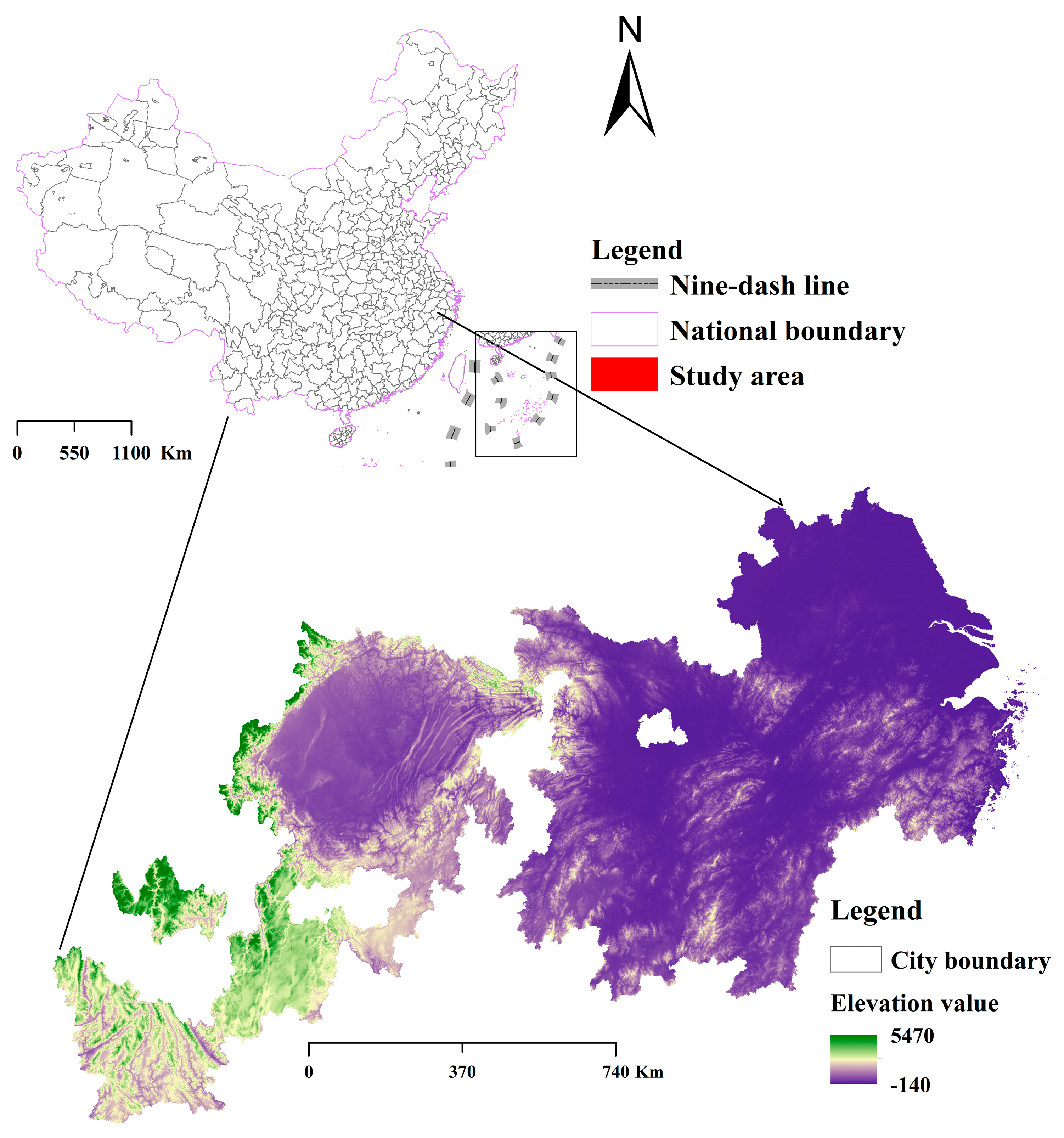
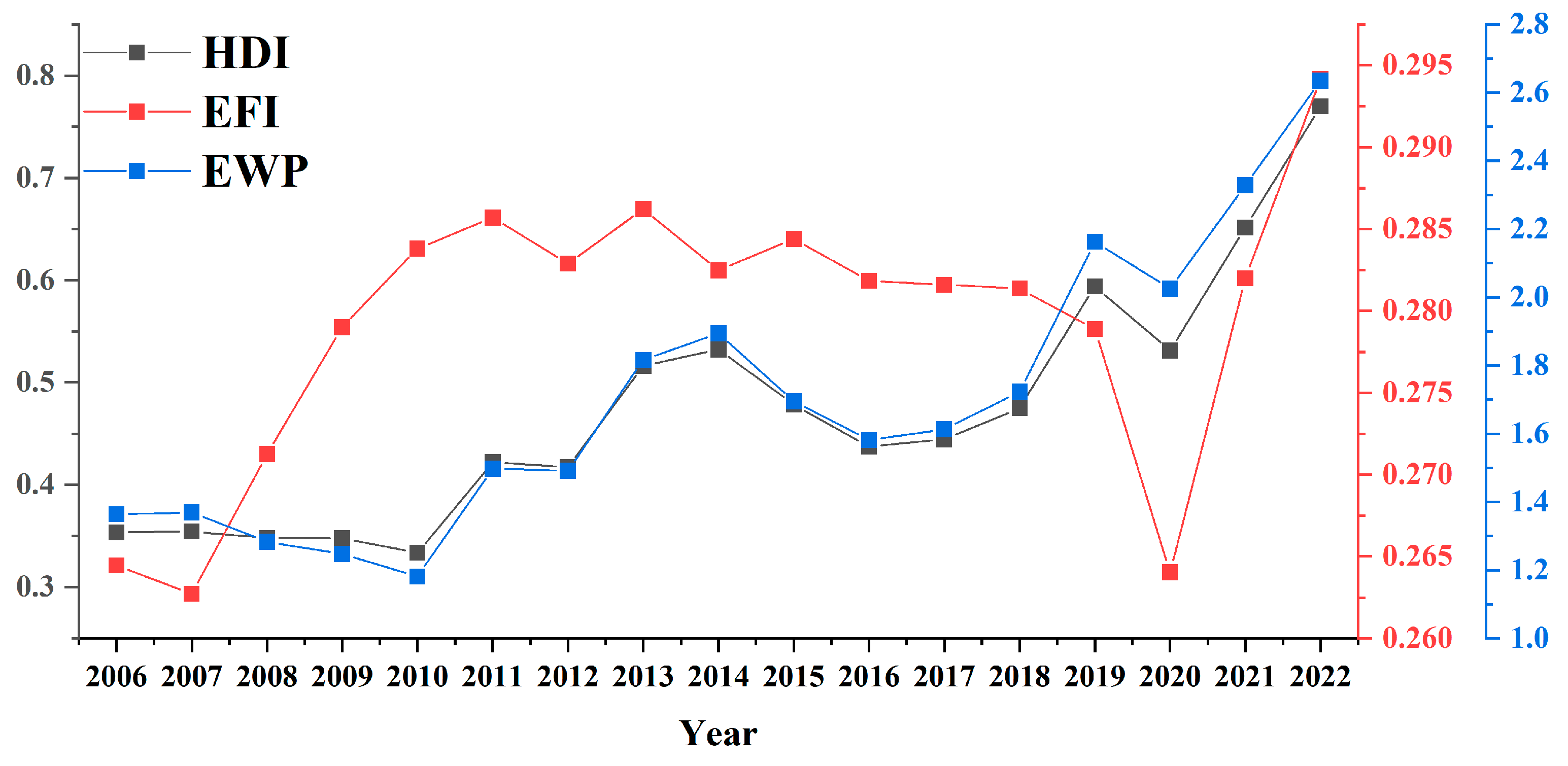
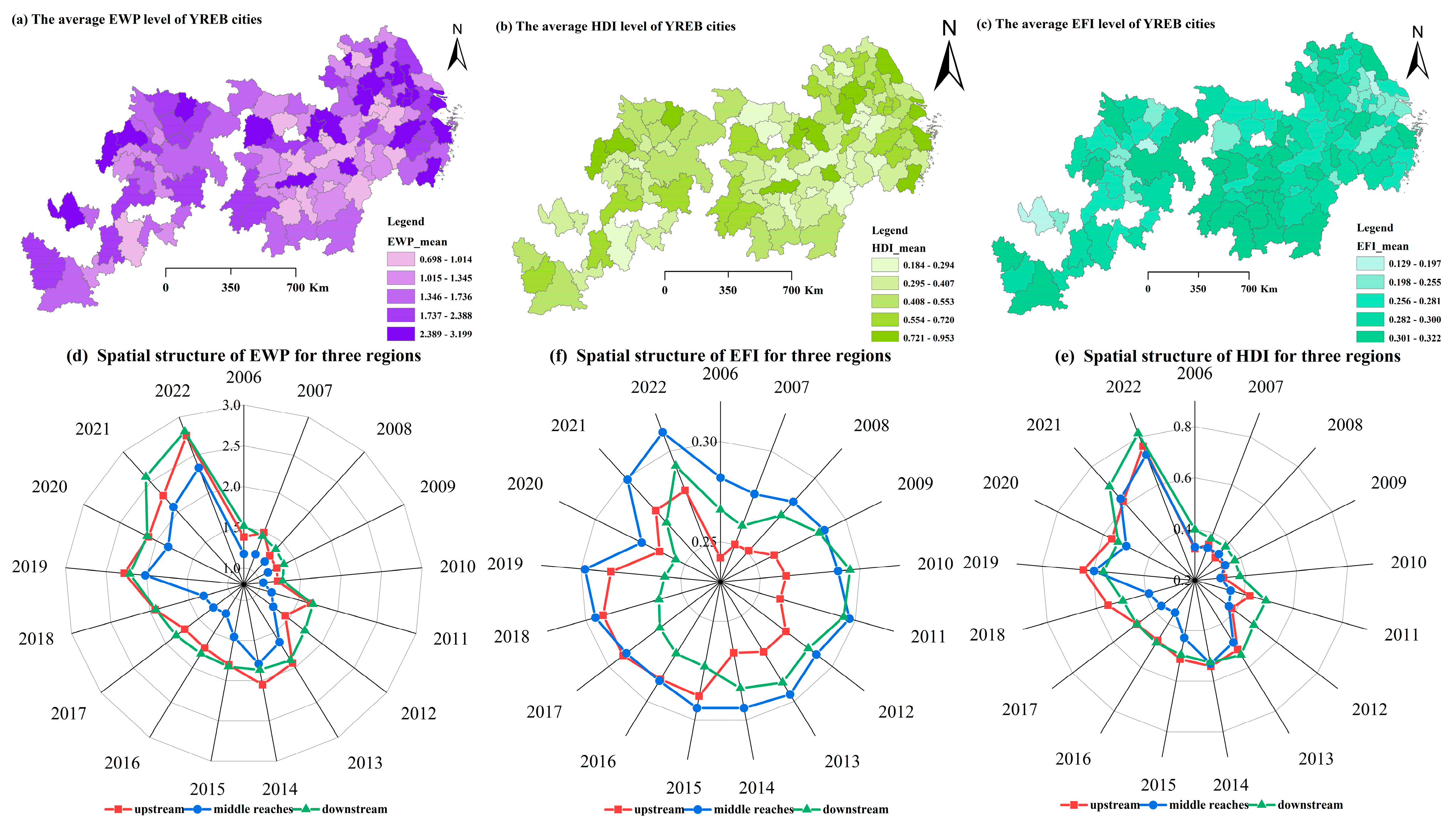
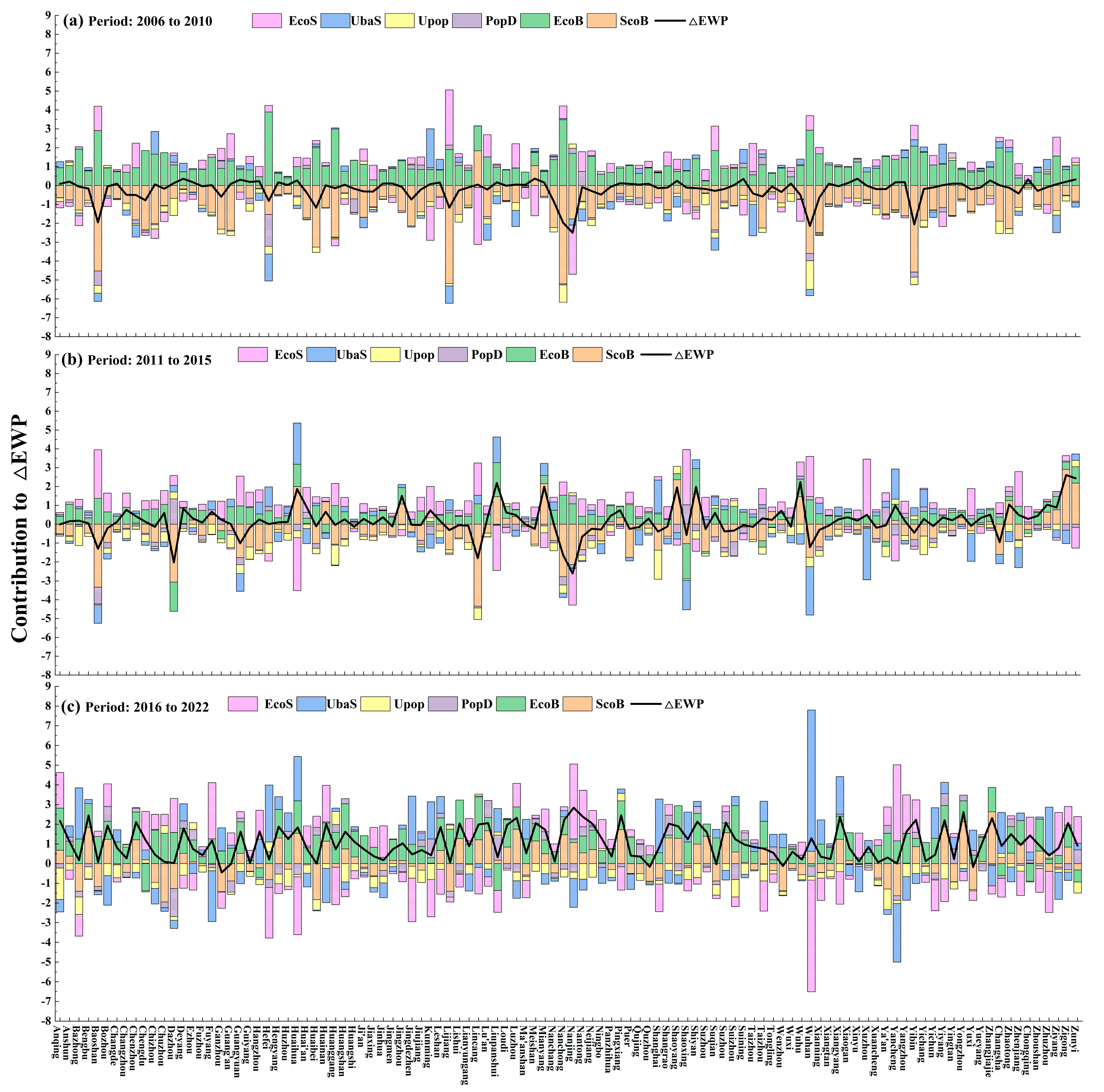
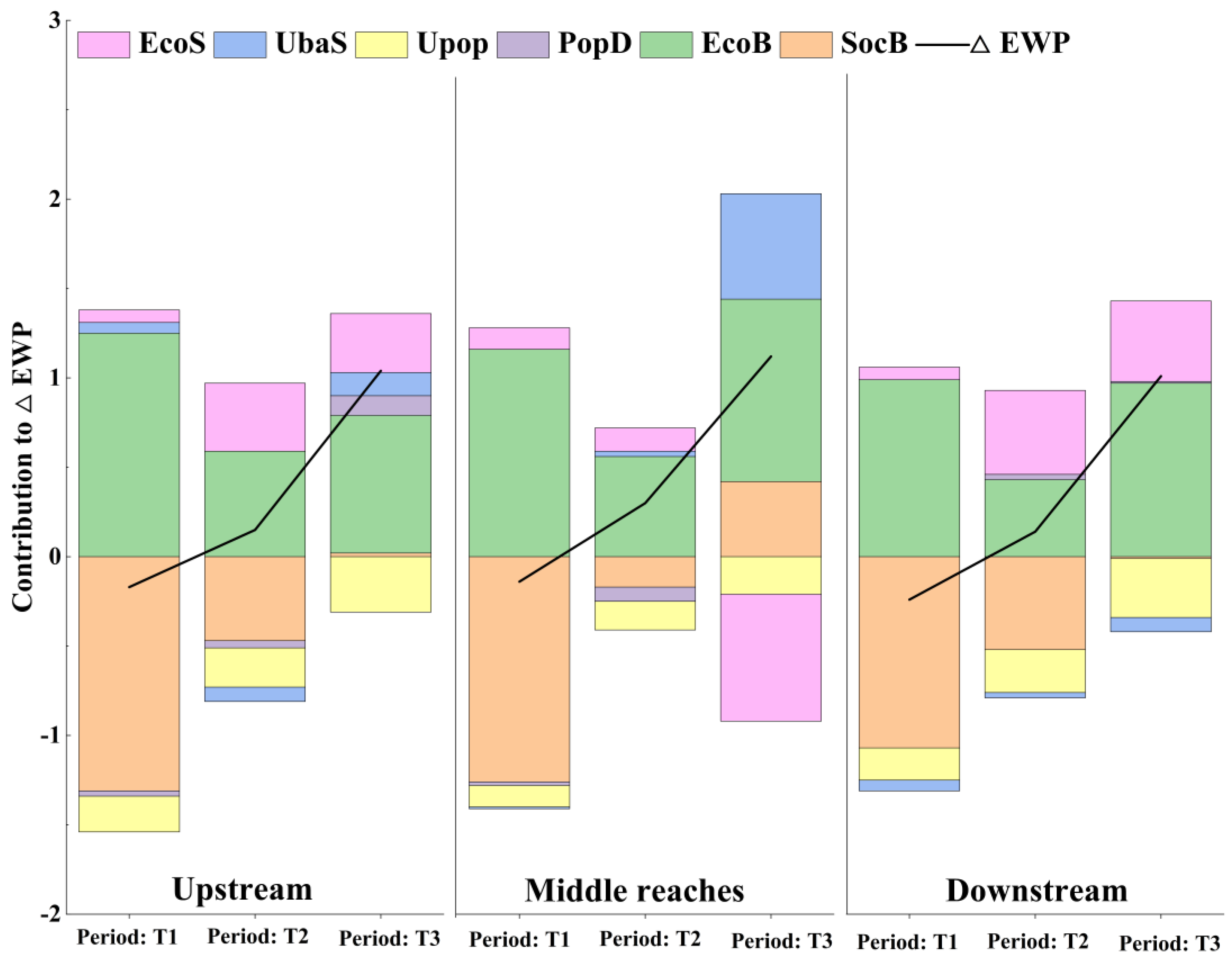

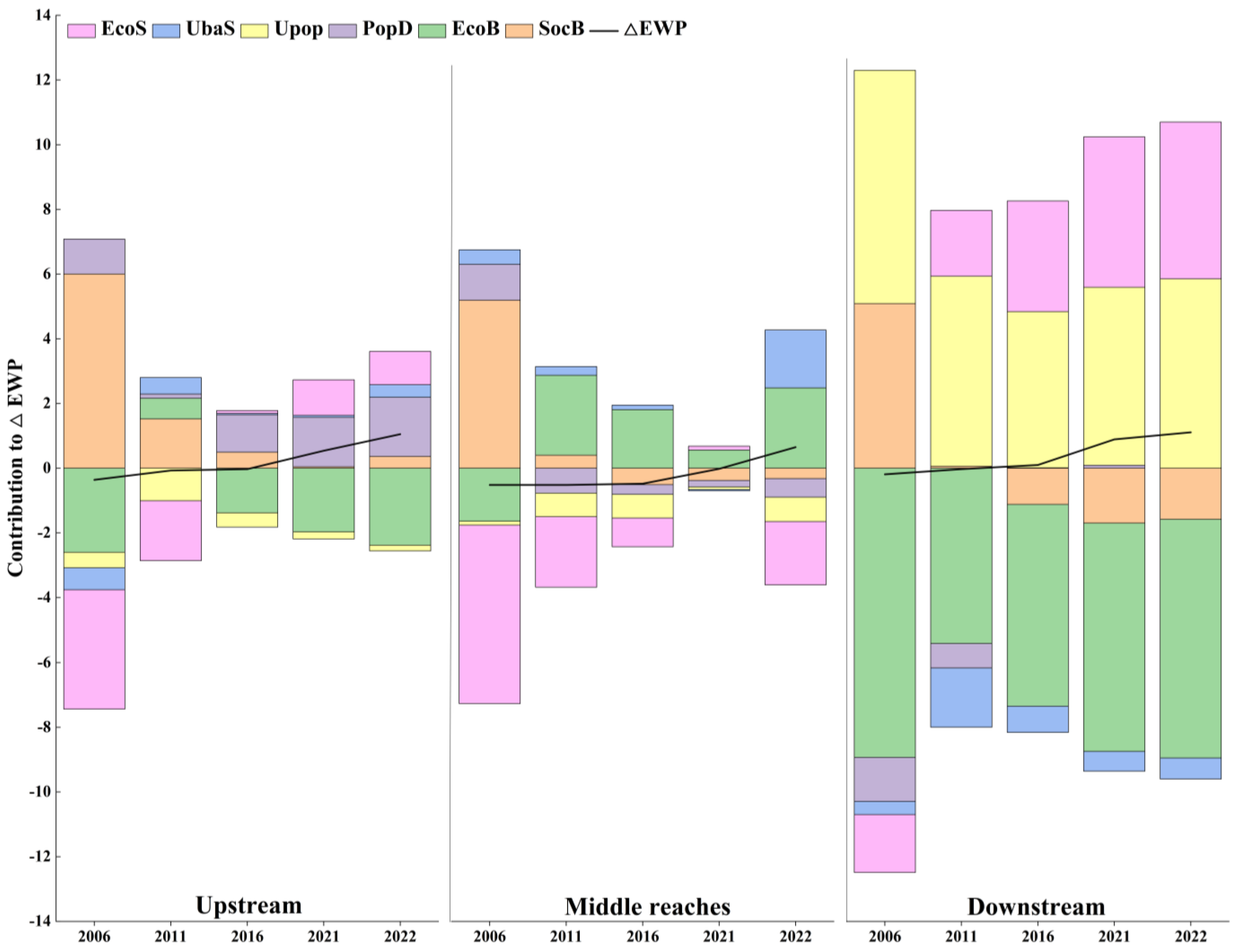
| Target | Dimension | Indicator | Entropy Weight |
|---|---|---|---|
| Human Development Index | economy | Per capita GDP | 0.301 |
| education | Adult literacy rate | 0.146 | |
| Comprehensive enrollment rate | 0.193 | ||
| health | Number of medical institution beds per ten thousand inhabitants | 0.199 | |
| Doctors per ten thousand inhabitants | 0.161 |
Disclaimer/Publisher’s Note: The statements, opinions and data contained in all publications are solely those of the individual author(s) and contributor(s) and not of MDPI and/or the editor(s). MDPI and/or the editor(s) disclaim responsibility for any injury to people or property resulting from any ideas, methods, instructions or products referred to in the content. |
© 2024 by the authors. Licensee MDPI, Basel, Switzerland. This article is an open access article distributed under the terms and conditions of the Creative Commons Attribution (CC BY) license (https://creativecommons.org/licenses/by/4.0/).
Share and Cite
Yang, J.; Li, Z. Improving Urban Ecological Welfare Performance: An ST-LMDI Approach to the Yangtze River Economic Belt. Land 2024, 13, 1318. https://doi.org/10.3390/land13081318
Yang J, Li Z. Improving Urban Ecological Welfare Performance: An ST-LMDI Approach to the Yangtze River Economic Belt. Land. 2024; 13(8):1318. https://doi.org/10.3390/land13081318
Chicago/Turabian StyleYang, Jie, and Zhigang Li. 2024. "Improving Urban Ecological Welfare Performance: An ST-LMDI Approach to the Yangtze River Economic Belt" Land 13, no. 8: 1318. https://doi.org/10.3390/land13081318
APA StyleYang, J., & Li, Z. (2024). Improving Urban Ecological Welfare Performance: An ST-LMDI Approach to the Yangtze River Economic Belt. Land, 13(8), 1318. https://doi.org/10.3390/land13081318







